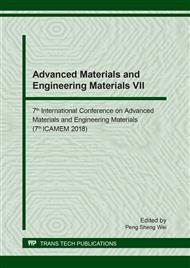[1]
C. Borr, M. Gagliardi, M. Paggi, Fatigue crack growth in Silicon solar cells and hysteretic behaviour of busbars, Solar Energy Materials and Solar Cells (2018).
DOI: 10.1016/j.solmat.2018.02.016
Google Scholar
[2]
E. J. Schneller, R. P. Brooker, N. S. Shiradkar, M. P. Rodgers, N. G. Dhere, K. O. Davis, H. P. Seigneur, N. Mohajeri, J. Wohlgemuth, G. Scardera, A. C. Rudack, W. V. Schoenfeld, Manufacturing metrology for c-Si module reliability and durability Part III: Module manufacturing, Renewable and Sustainable Energy Reviews 59 (2016).
DOI: 10.1016/j.rser.2015.12.215
Google Scholar
[3]
J. A. Ahmar, S. Wiese, A crack analysis model for silicon based solar cells, 15th international Conference on Thermal, Mechanical and Multi-Physics Simulation and Experiments in Microelectronics and Microsystems (2014).
DOI: 10.1109/eurosime.2014.6813855
Google Scholar
[4]
S. K. Schröder, I. Kunze, U.Eitner, M. Köntges, Spatial and orientational distribution of cracks in crystalline photovoltaic modules generated by mechanical load tests, Solar Energy Materials & Solar Cells 95 (2011) 3054–3059.
DOI: 10.1016/j.solmat.2011.06.032
Google Scholar
[5]
F. Kraemer, J. Seib, E. Peter, S. Wiese, Mechanical Stress Analysis in Photovoltaic Cells during the String-Ribbon Interconnection Process, 15th international Conference on Thermal, Mechanical and Multi-Physics Simulation and Experiments in Microelectronics and Microsystems (2014).
DOI: 10.1109/eurosime.2014.6813853
Google Scholar
[6]
T. Geipel, M. Moeller, J. Walter, A. Kraft, U. Eitner, Intermetallic compounds in solar cell interconnections: Microstructure and growth kinetics, Solar Energy Materials & Solar Cells 159 (2017) 370-388.
DOI: 10.1016/j.solmat.2016.08.039
Google Scholar
[7]
A. M. Gabor, M. Ralli, S. Montminy, L. Alegria, C. Bordonaro, J. Woods, L. Felton, Soldering induced damage to thin Si solar cells and detection of cracked cells in modules, 21st European Photovoltaic Solar Energy Conference (2006).
Google Scholar
[8]
O. O. Ogbomoa, E. H. Amalub, N. N. Ekerea, P. O. Olagbegic, Effect of coefficient of thermal expansion (CTE) mismatch of solder joint materials in photovoltaic (PV) modules operating in elevated temperature climate on the joint's damage, Procedia Manufacturing 11 (2017).
DOI: 10.1016/j.promfg.2017.07.236
Google Scholar
[9]
Y. Zemen, T. Prewitz, T. Geipel, S. Pingel, J. Berghold, The impact of yield strength of the interconnection on the internal stress of the solar cell within a module, 25th European Photovoltaic Solar Energy Conference and Exhibition (2010).
Google Scholar
[10]
H. Xiong, C. Gan, Z. Hu, H. Niu, J. Li, J. Si, P. Xing, X. Luo, Formation and Orientational Distribution of Cracks Induced by Electromagnetic Induction Soldering in Crystalline Silicon Solar Cells, IEEE Journal of Photovoltaics, 7 (2017) 966-973.
DOI: 10.1109/jphotov.2017.2693442
Google Scholar
[11]
J. Waltera, L. C. Rendlera, A. Halmb, V. Mihailetchib, A. Krafta, U. Eitner, Ribbon interconnection of 6" BC-BJ solar cells, Energy Procedia 124 (2017) 504-514.
DOI: 10.1016/j.egypro.2017.09.287
Google Scholar
[12]
D. Cao, H. Yang, H. Wang, The Effect of soldering process on solar module performance, 40th Photovoltaic Specialist Conference (2014) 2681-2684.
DOI: 10.1109/pvsc.2014.6925481
Google Scholar
[13]
P. Schmitt, P. Kaiser, C. Savio, M. Tranitz, U. Eitner, Intermetallic Phase Growth and Reliability of Sn-Ag-Soldered Solar Cell Joints, Energy Procedia 27 (2012) 664-669.
DOI: 10.1016/j.egypro.2012.07.126
Google Scholar
[14]
Y. C. Chan, P. L. Tu, A. C. K. So, J. K. L. Lai, Effect of Intermetallic Compounds on the Shear Fatigue of Cu/63Sn–37Pb Solder Joints, IEEE Transaction on components, Packaging, and Manufacturing Technology-Part B 20 (1997) 463-469.
DOI: 10.1109/96.641516
Google Scholar
[15]
A. Mansouri, M. Zettl, O. Mayer, M. Lynass, M. Bucher, O. Stern, C. Heller, E. Mueggenburg, Defect detection in photovoltaic modules using electroluminescence imaging using electroluminescence imaging, 27th EU PVSEC (2012).
Google Scholar
[16]
B. Lalaguna, P. Sánchez-Friera, H. Mäckel, D. Sánchez, J. Alonso, Evaluation of stress on cells during different interconnection processes, 23rd European Photovoltaic Solar Energy Conference (2008) 2705-2708.
Google Scholar


